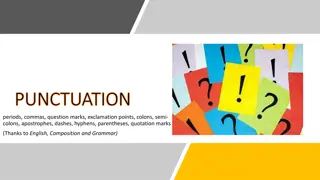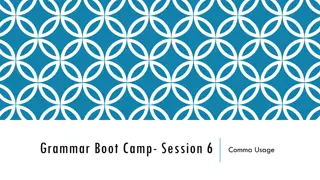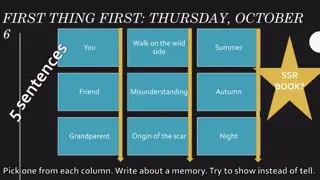Mastering Commas: Usage Guide with Examples
Learn how to use commas correctly in various situations such as dialogue, direct quotations, geographical names, dates, personal titles, adjectives, series, and conjunctions. This comprehensive guide provides clear examples and explanations to help you enhance your writing skills.
Download Presentation

Please find below an Image/Link to download the presentation.
The content on the website is provided AS IS for your information and personal use only. It may not be sold, licensed, or shared on other websites without obtaining consent from the author. Download presentation by click this link. If you encounter any issues during the download, it is possible that the publisher has removed the file from their server.
E N D
Presentation Transcript
Comma Usage Adapted from Real Good Grammar, Too by Mamie Webb Hixon
Dialogue and Direct Quotations Use a comma to separate direct quotations from the phrase identifying the speaker: Johnny moaned, Grammar lessons are so lame. I m tired, he complained, and I want to go home.
Geographical Names Use a comma to separate geographical names and addresses from each other and from words following them: Pensacola, Florida, is where I live. Birmingham, Alabama, gets its name from Birmingham, England. The property located at 4590 Peach Street, Atlanta, Georgia 32416, is for sale. Note: Don t place a comma between the state and the zip code.
Dates Use a comma to separate dates from text when using the month-day-year sequence: Earth Day was founded on April 22, 1970, and is celebrated every year on April 22. Do not use comma when using only two date items: April 22 is Earth Day April 1970 marks the founding of Earth Day.
Personal Titles Use a comma to separate titles following names: David H. Baldwin, M.D., will be the principal speaker. Mary Hines, Senior Vice President of Creative Technology, will conduct the interview.
Commas with Adjectives Use a comma to separate two or more coordinate descriptors/adjectives: Coordinate descriptors can be flipped around; separate them with commas. Non-coordinate descriptors cannot be flipped; do not separate them with commas. He was a happy, intelligent child. He was an intelligent, happy child. She often wore grey wool socks. She often wore wool gray socks.
Items in a Series Use a comma to separate three or more items or phrases in a series: I was so bored during the play that I texted on my phone, chewed on my pen, and wrote notes to my neighbor. Several other audience members sat quietly, paid attention, and took inspiration from the play.
Commas with FANBOYS Use a comma + one of the FANBOYS (for, and, nor, but, or, yet, so) to join two complete sentences: The baby was trying to clap along with the rhythm, but the tempo was too fast. I am having trouble with my computer, so I m going to take it in for repairs. Do not join two complete sentences with a comma alone: I got up late this morning, I did not have time for breakfast.
Introductory Elements Use a comma to separate introductory words, phrases, or clauses from the main sentence: Because she didn t set her alarm, she was late for class. If she is late again, her grade will suffer. Note: Introductory phrases often begin with after, during, at, by, for, from, until, because of, due to, in, to, with, without. Do not add a comma if the introductory clause falls at the end of the sentence: She was late for class because she didn t set her alarm. Her grade will suffer if she is late again.
Essential vs. Nonessential Info Use commas to separate nonessential words, clauses, or phrases: John is my best friend. John, who has black hair, is my best friend. Here, we don t need to know that John has black hair to understand that the point of the sentence is that John is the speaker s best friend. Omit the commas if the information is essential: John Wiggins had black hair. John Edwards has red hair. John who has black hair is my best friend. Here, we have two Johns, one with black hair and one with red hair. Who has black hair is necessary to the meaning of the sentence because this information distinguishes between John Wiggins, who is the speaker s best friend, and John Edwards, who is not the speaker s best friend.
Direct Address Use a comma to separate names used in direct address from the main sentence: Let s eat, Grandma. The speaker is addressing Grandma to invite her to come to the table. Without the comma, this sentence says, Let s eat Grandma. Presumably, the speaker does not want to eat any grandparents.
Tag Questions Use a comma to separate mild interjections and words like yes, no, and thanks from the main sentence: Yes, I do want fries with that. Oh, I don t know. Use a comma to separate tag question from the main sentence: You are not distracted, are you? You killed my goldfish, didn t you?
Interrupters Use a comma to separate interrupters, parenthetical words and phrases, and transitional words and phrases from the main sentence: My ferret, by the way, loves to wear a fedora. My hamster, however, prefers his baseball cap.
Consecutive Occurrences Use a comma to separate two or three consecutive occurrences of a word: Rain, rain, go away. I see your lips moving, but all I hear is blah, blah, blah.
Commas for Clarity Use a comma to provide clarity and to prevent misreading: We left the candidate, assured that he would win. By separating the word assured from the main sentence with a comma, we show that the one who is assured is the same person as the subject of the sentence: we were assured. We left the candidate assured that he would win. By omitting the comma, we attach the word assured to the word candidate, showing that it is the candidate who was assured.























